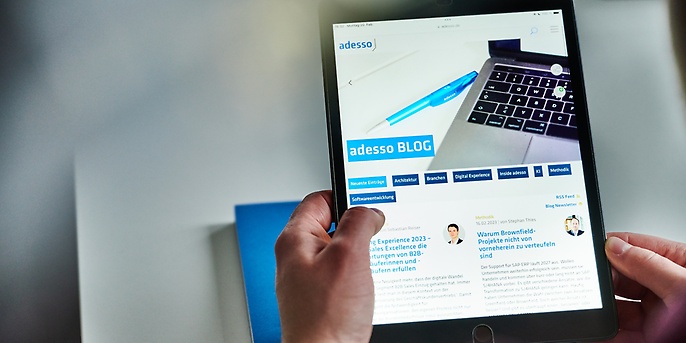19. August 2024 By Björn Becker
AI-driven design: trends and opportunities for digital healthcare applications
Artificial intelligence (AI) is opening up a new era of innovation and precision in modern medical technology. This technology makes it possible to analyse vast amounts of data, identify complex patterns and make informed decisions that significantly improve the efficiency and quality of healthcare. AI is being used in numerous applications, from medical imaging to personalised treatment plans, and is fundamentally changing the way we practice medicine.
AI-driven design: a key to the future
AI-driven design is a particularly exciting field of application for AI. Here, advanced algorithms and machine learning are used to fundamentally support and optimise the design process of healthcare products. AI-supported tools analyse extensive healthcare data, identify relevant trends and patterns and derive innovative design ideas or optimisation proposals from this. This process leads to more precise and efficient medical devices and applications that significantly improve the quality of healthcare.

Procedure for the integration of AI-Driven Design in software applications
- Collecting and analysing data: AI systems collect and analyse different amounts of healthcare data from system-relevant resources, including patient records, medical imaging, research results and user feedback. This data serves as the basis for the subsequent steps.
- Pattern recognition: Using machine learning algorithms, the AI recognises patterns and relationships in the collected data. This enables the AI to understand and apply certain medical design principles and requirements.
- Generating designs: Based on the recognised patterns and principles, the AI can independently create new designs for medical devices or applications. This is often done through generative modelling, which can produce realistic and innovative healthcare solutions.
- Optimisation and adaptation: AI can also optimise existing healthcare products, for example by increasing user-friendliness, improving functionality or increasing efficiency. This often happens in iterative processes in which AI continuously suggests and tests improvements.
Future scenarios for the healthcare market
The integration of AI-driven design into the healthcare market harbours enormous potential for innovation and progress. The following two practical examples of future healthcare applications illustrate the opportunities offered by AI-driven design:
1. the personalised health app ‘HealthMate’:
Imagine opening your mobile phone app called ‘HealthMate’ in the morning to start your day. HealthMate is a personal health companion, an AI-supported application that monitors your daily activities and gives you customised training and nutrition recommendations.
With every step you take, every workout you do and every meal you eat, HealthMate learns from you. It recognises your preferences, your goals and even your limitations, be it a physical challenge or an allergy. This information flows into the app's personalised recommendations.
For example, if you start taking your medication every morning, the app will show you the relevant component, while other users will be shown their daily goals first, for example.
But HealthMate goes even further. It follows accessibility guidelines to ensure that its features are accessible to all. Whether you're visually impaired and need voice guidance or you're in a wheelchair and need special training adaptations, HealthMate is prepared to support you.
No matter who you are and what challenges you face, HealthMate recognises your personal needs and offers a customised user interface with tailored content management.
2. digital decision aid ‘MediAssist’
A maximum care hospital with various specialised departments relies on the ‘MediAssist’ software for digital decision support. This clinical decision-making platform works with design-oriented AI technology that adapts to the individual requirements of different medical specialities.
Imagine a doctor in the emergency department. In a constant stream of patients, he or she has to act quickly and make precise decisions. This is where MediAssist comes into play. With an intuitive user interface, the platform immediately presents all relevant information on acute cases, including priority lists, suggested diagnoses and treatment options. This enables the doctor to act quickly and efficiently and save lives. If he or she later moves to another area of the hospital, the platform automatically adapts to the specific requirements of the speciality. For medical specialists, MediAssist offers specialised diagnosis and treatment options that are tailored precisely to their needs.
This customisability of MediAssist is key to improving clinical efficiency. By providing customised support, the platform reduces errors and ultimately contributes to better patient outcomes. In the hands of the doctor, MediAssist becomes an indispensable tool that redefines the boundaries of medical care.
These examples show how AI-driven design can help improve the efficiency, accuracy and usability of healthcare solutions, positively impacting patient wellbeing and the efficiency of the entire healthcare system.
Advantages of AI-driven design
The integration of AI-driven design into healthcare offers a number of benefits that optimise the design process and drive the development of innovative healthcare solutions. Below are the five most relevant benefits:
Personalised user experience
AI-powered design enables the development of healthcare solutions that take into account the individual needs and preferences of users. By analysing large data sets, the software can generate personalised recommendations and customised treatment plans that are tailored to the specific health goals and needs of each individual user. This leads to an improved user experience and increases the likelihood that those affected will use the application in the long term.
Increasing efficiency in the healthcare sector
AI-powered design can significantly increase efficiency in healthcare by automating repetitive tasks and optimising workflows for healthcare professionals. In addition, less guidance is required for users as the software systems are customised to their needs. This increases the likelihood that users will be able to use the applications effectively and functionally from the outset.
Improved accuracy and quality of diagnosis
AI algorithms can analyse large amounts of medical data and recognise patterns that may not be obvious to human observers. This can help to improve the accuracy of diagnoses and increase the overall quality of medical care. By supporting doctors in making diagnoses, AI-supported design solutions can help to reduce misdiagnoses and increase patient safety. Long-term customer loyalty and thus sustainable company growth.
Cost efficiency and scalability
Implementing AI-driven design can help reduce healthcare costs by automating repetitive tasks and optimising resource utilisation. In addition, AI-driven solutions can be scalable, meaning that costs do not increase proportionally as utilisation increases.
Competitive advantage and innovation
Companies that integrate AI-driven design into their healthcare solutions can gain a competitive advantage by offering innovative and user-centred products and services. By utilising AI technologies, companies can differentiate themselves from their competitors and build a reputation as a pioneer in the industry. This can help to attract new customers and retain existing customers in the long term, ultimately leading to sustainable business growth.
Summary and outlook
To summarise, AI-driven design represents a promising future for digital health applications. By integrating artificial intelligence into the design process, personalised, user-centric solutions can be developed that help to increase efficiency, improve the user experience and ultimately transform healthcare.
It is expected that the use of AI in healthcare design will continue to increase in the coming years. Advances in areas such as machine learning and data analytics will make it possible to develop even more precise and personalised healthcare solutions. Overall, the fusion of AI and design has enormous potential to transform the healthcare industry and provide better care options for patients worldwide.
Would you like to find out more about exciting topics from the world of adesso? Then take a look at our previous blog posts.
GenAI@adesso
Would you like to find out more about GenAI and how we can support you? Then take a look at our website. Podcasts, blog posts, events, studies and much more - we offer you a compact overview of all topics relating to GenAI.



